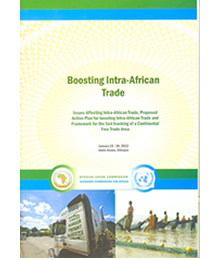Action Plan for Boosting Intra-Africa Trade
The Assembly of the Heads of State and Government of the African Union adopted, during its 18th Ordinary Session that was held in Addis Ababa, Ethiopia, in January 2012, the decision (Assembly/ AU/Dec.394 [XVIII]) to establish a Pan- Africa Continental Free Trade Area (CFTA) by
the indicative date of 2017. It also endorsed an Action Plan for Boosting Intra-Africa Trade (BIAT). This historic Summit Decision is aimed at deepening Africa’s market integration and using trade to serve more effectively as an instrument for the attainment of rapid and sustainable socio-economic development. The decision is in line with the overarching objectives set for the African Union by its founding fathers: to “accelerate the process of implementing the Treaty establishing the African Economic Community in other to promote the socio-economic development of Africa and to face more effectively the challenges posed by globalization” and to “promote sustainable development at the economic, social and cultural levels as well as the integration of African economies.”
Over the decades, several major initiatives have been adopted for the promotion of Africa’s socio-economic development. Unfortunately, many of these initiatives have failed to achieve their stated objectives. The missing link between goals and achievements has been effective implementation of programmes and policies. Quite often, there is the absence of a strategic framework and institutional arrangements, including a monitoring and evaluation mechanism, to drive the process of implementation of the initiative towards the attainment of its objectives.
It is to ensure that the CFTA and BIAT initiative achieves its laudable objectives of boosting intra-Africa trade and accelerating Africa’s market integration that the AU Summit has established, as part of the CFTA Architecture, a High-Level African Trade Committee (HATC), comprising of Heads of State and Government (the Chairs of the Regional Economic Communities {RECs}) to play a facilitating role and unlock any blockages that might arise in the implementation of the CFTA and BIAT agenda. Also, in endorsing the BIAT Action Plan, the Summit directed the AUC, in collaboration with the RECs and development partners, “to develop an implementation strategy for the Action Plan”.
The BIAT Action Plan Clusters
The Action Plan for Boosting Intra-Africa Trade, as endorsed by the AU Summit, contains seven major clusters, the implementation of whose programmes and activities is aimed at addressing the key constraints and challenges of intra-African trade and at significantly enhancing the size and benefits of the trade for the attainment of sustainable economic growth and development. The clusters cover:
- Trade Policy
- Trade Facilitation
- Productive Capacity
- Trade-Related Infrastructure
- Trade Finance
- Trade Information and
- Factor Market Integration
Under each of these clusters, the BIAT Action Plan provides, in broad terms, an indicative list of programmes and activities that need to be implemented in the short to long terms at the national, regional and continental levels.
